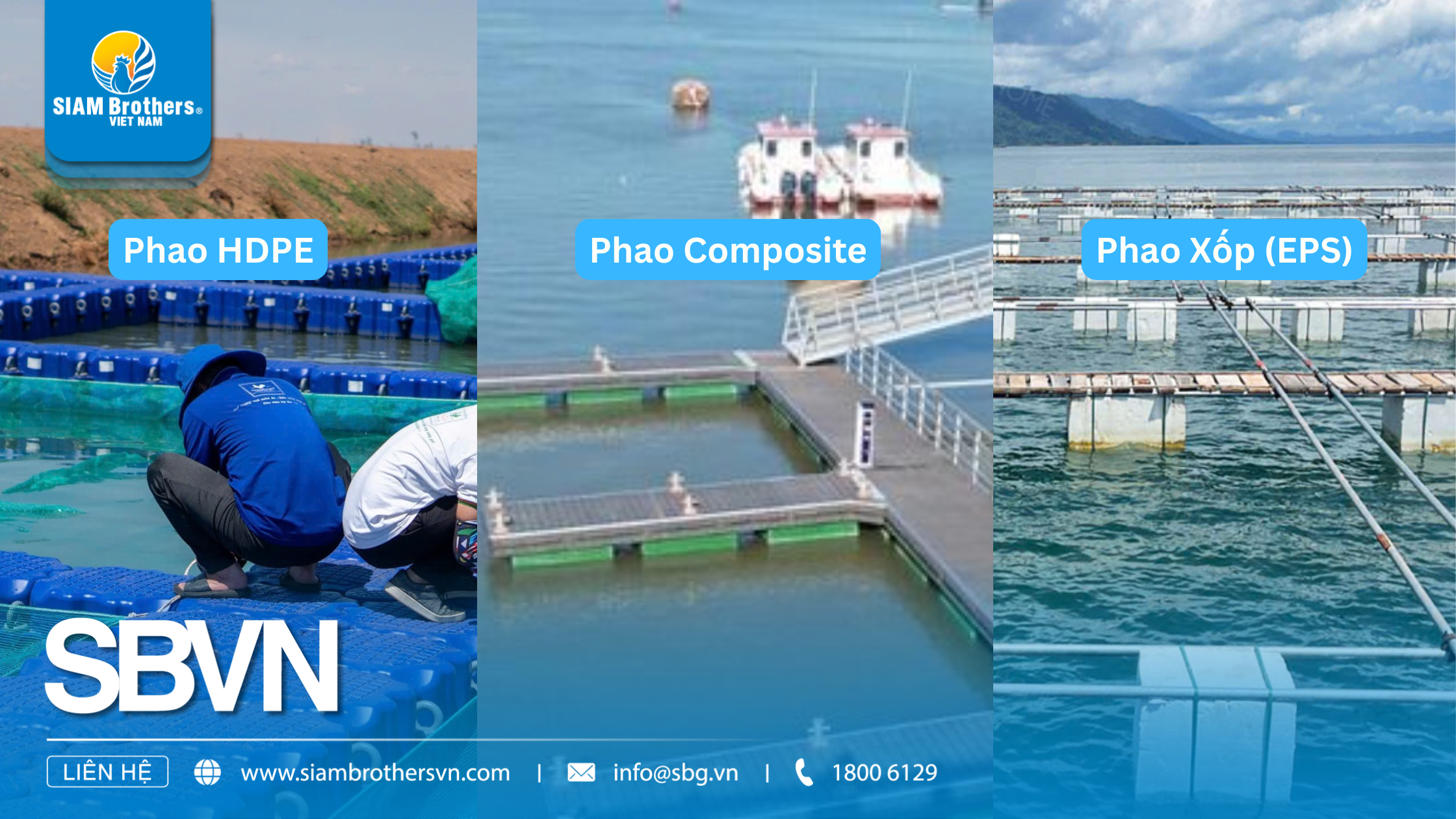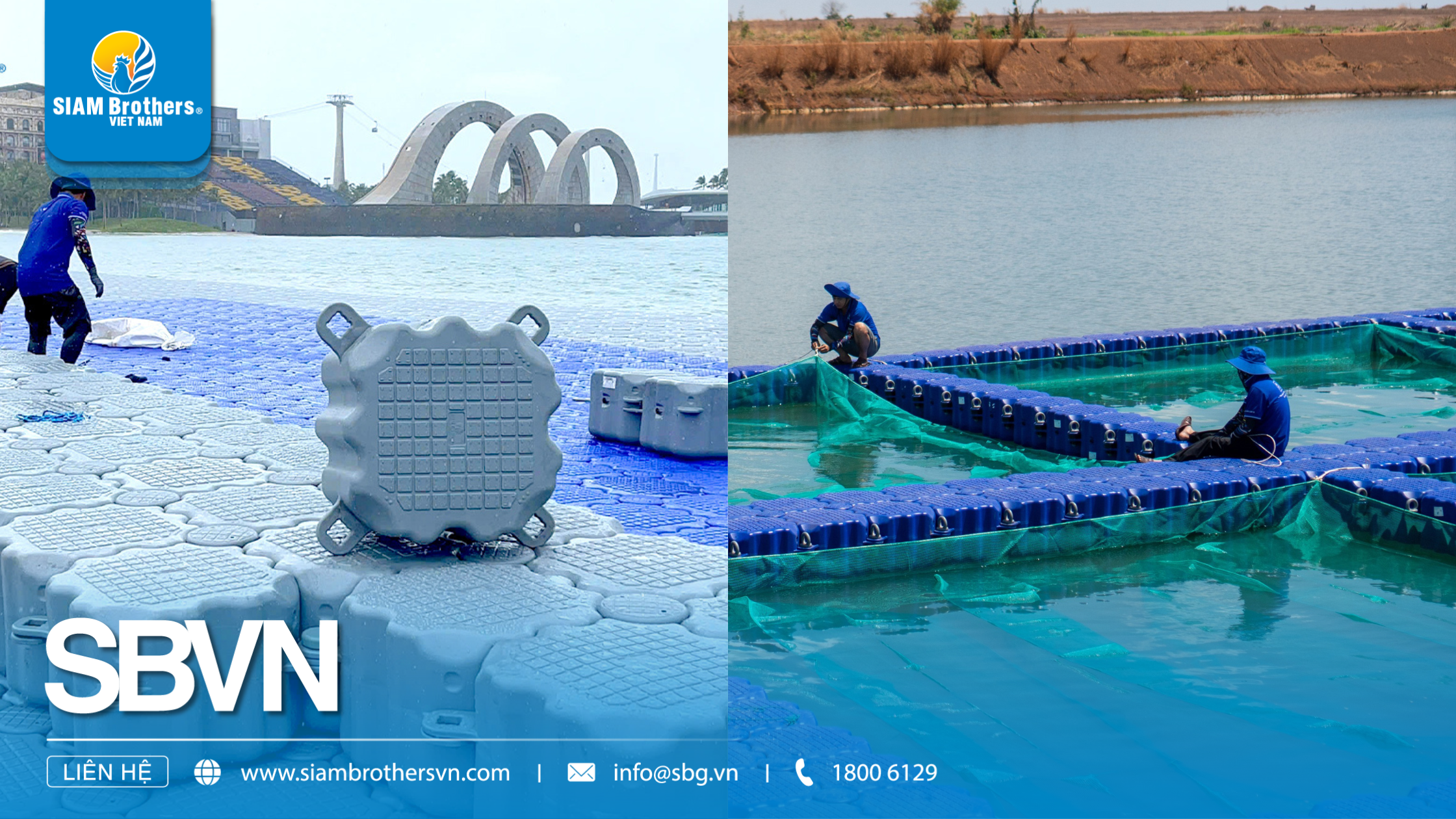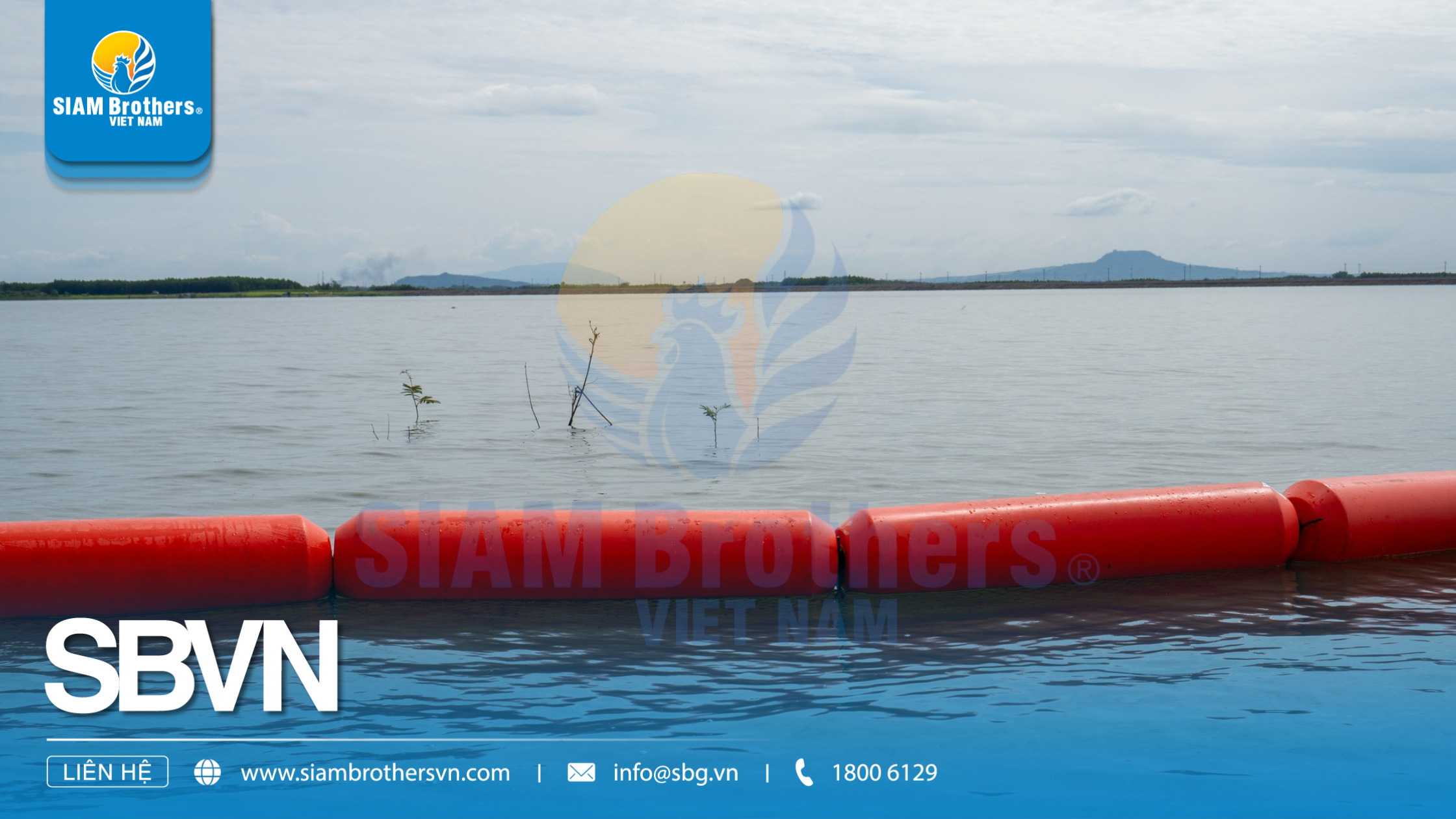River floating buoys not only help stabilize equipment and regulate water flow but also play a vital role in applications such as aquaculture, boat mooring, and floating waste barriers for environmental protection. However, choosing the right type of buoy — HDPE, composite, or foam — is essential to ensure durability and long-term performance. In this guide, SIAM Brothers Vietnam provides practical instructions on how to select the right river floating buoys for each purpose, analyzes the advantages and limitations of each material, and suggests optimal solutions from SIAM Brothers Vietnam, a leading manufacturer of internationally certified HDPE floating buoys.
1. What Are River Floating Buoys? Functions and Operating Principles
River floating buoys are buoyant devices made from water-resistant materials capable of withstanding harsh environmental conditions, such as HDPE, composite, or EPS foam. They are commonly used to stabilize floating structures, secure aquaculture cages, support floating walkways, and serve as waste-blocking or navigation-guiding buoys.
At SIAM Brothers Vietnam, all floating buoys are manufactured according to strict technical standards, ensuring high load capacity, UV resistance, and anti-corrosion performance, making them suitable for rivers, canals, and brackish coastal waters.
1.1 Practical Roles of River Floating Buoys
River floating buoys are not just technical accessories; they are essential components that maintain safety and efficiency across various sectors:
- Aquaculture: Stabilizing fish cages and preventing collisions under strong water flow.
- Waterway transportation: Used as navigation markers or channel buoys to guide vessels safely.
- Environmental protection: Applied as floating waste barriers to stop debris and plastic waste from drifting downstream.
- Tourism and civil projects: Used to build floating platforms, modular walkways, or temporary floating piers.
1.2 How River Floating Buoys Work
River floating buoys operate based on Archimedes’ principle — objects with a lower density than water will float.
Key factors influencing buoy performance include:
- Material density: HDPE has a lower density than water, allowing excellent buoyancy and zero water absorption.
- Sealed air-chamber structure: Prevents water intrusion and maintains stable buoyancy over time.
- Geometric design: Cylindrical, spherical, or modular shapes help distribute loads evenly and adapt to varying water flow conditions.
2. Comparison Table of the 3 Most Common Types of River Floating Buoys
| Evaluation Criteria |
HDPE Buoys |
Composite Buoys |
Foam (EPS) Buoys |
| Material |
Virgin UV-stabilized HDPE |
Fiber-reinforced composite |
Compressed EPS foam, sometimes thinly coated |
| Durability & Lifespan |
High (10–15 years), impact-resistant, weatherproof |
Good (7–10 years), but prone to cracks under strong impact |
Low (2–3 years), easily broken and absorbs water if uncoated |
| Load Capacity |
Excellent for large-scale floating structures |
Moderate, suitable for calm waters |
Limited; best for temporary setups |
| Weight & Mobility |
Lightweight, easy to install, flexible |
Heavier, requires fixed support frames |
Very light but unstable |
| Corrosion Resistance |
Excellent; resistant to saltwater, acids, and chemicals |
Good but decreases over time |
Poor; degrades quickly with prolonged water exposure |
| Aesthetics & Maintenance |
Color-fast, low maintenance |
Good appearance but requires periodic coating |
Fades quickly and deteriorates |
| Suitable Applications |
Fish cages, waste barriers, floating platforms, modular docks |
Navigation buoys, waterway markers |
Calm, temporary, or small-scale setups |
| Initial Investment |
Medium to high but cost-effective long-term |
Medium, suitable for mid-scale projects |
Low upfront cost but high replacement cost |

Technical Evaluation: Strengths and Weaknesses of Each Buoy Type
HDPE Buoys
The most advanced option today thanks to superior UV resistance, impact strength, and long lifespan. Ideal for rivers with strong currents or large-scale floating systems.
Composite Buoys
Suitable for calm or inland waters. However, they require periodic maintenance to prevent cracking and surface degradation.
Foam (EPS) Buoys
Affordable and easy to deploy, but not durable. Best for short-term or low-budget applications.
3. How to Choose the Right River Floating Buoys for Each Application
3.1. Key Principles for Selecting Effective River Floating Buoys
Flow conditions and environment: Still water, fast-flowing rivers, or brackish coastal zones.
- Intended use: Mooring, trash barriers, aquaculture, or tourism.
- Material durability: Resistance to UV, impacts, and chemical corrosion.
- Investment & maintenance costs: Balance upfront budget with long-term operational efficiency.
3.2. Choosing River Floating Buoys for Specific Applications
3.2.1. For Aquaculture
Recommended type: HDPE River Floating Buoys
- Features: One-piece molded design, high load-bearing capacity, stable flotation for fish or shrimp cages.
- Benefits: Non-absorbent, saltwater-resistant, easy to assemble and maintain.
- SIAM Brothers VN recommendation: Use industrial-grade HDPE buoys paired with PP or anti-twist mooring accessories to extend system lifespan.
3.2.2. For River Trash Barriers & Environmental Protection
- Recommended type: LLDPE or Composite River Floating Buoys
- Features: Durable structure, strong impact resistance, compatible with trash-blocking nets.
- Benefits: Easy installation, effective trash interception, minimal disruption to natural water flow.
- Real application: Saigon River and Nhieu Loc Canal trash-barrier projects using SIAM Brothers HDPE buoys with over 10-year durability.
- Recommended type: Modular HDPE floating systems or composite buoys
- Features: Flexible assembly to fit various layouts; safe for pedestrian use.
- Benefits: Anti-slip surface, high aesthetics, ideal for riverside resorts, tourism docks, and floating pontoons.
Note: Choose River Floating Buoys certified for safety and equipped with anti-vibration mooring systems for stability in wave-affected areas.

4. SIAM Brothers’ Real Projects in Vietnam
4.1. River Floating Buoy Project in Nghe An — Supporting Local Fishermen
- Location: Cam River, Nghe An
- Objective: Install HDPE buoys to stabilize aquaculture cages and secure mooring areas for fishing boats.
- Solution: High-strength HDPE buoys combined with PP/Nylon mooring ropes.
- Result: Improved cage stability in strong currents, reduced storm damage, and enhanced livelihood security for fishermen.
4.2. Saigon River Trash-Barrier Project — A Green Urban Solution
- Location: Binh Thanh District, Ho Chi Minh City
- Objective: Prevent floating waste, protect water quality, and reduce downstream pollution.
- Solution: HDPE River Floating Buoys paired with high-strength mooring systems.
- Result: Effective waste retention, reduced floating debris, and faster cleanup operations.
4.3. HDPE Buoy System for Aquaculture in Kien Giang
- Location: An Bien District, Kien Giang
- Objective: Build a sustainable buoy system for commercial fish farming.
- Solution: Corrosion-resistant HDPE buoys paired with PP ropes and safe mounting accessories.
- Result: Stable operation, lower maintenance costs, and improved aquaculture efficiency.

5. Frequently Asked Questions About River Floating Buoys
5.1. How to calculate the required number of river buoys?
It depends on project load, surface area, and expected operating weight. SIAM Brothers engineers calculate buoyancy + HDPE load capacity for optimal stability.
5.2. Can River Floating Buoys withstand strong currents?
HDPE and composite buoys are engineered for impact resistance and strong flows. Using high-quality mooring ropes increases stability.
5.3. What technical standards should be considered?
Look for ISO, Lloyd''s and SGS certifications, UV resistance, load capacity, and chemical resistance indicators.
5.4. Do River Floating Buoys require maintenance?
Yes. Inspect every 6–12 months to clean surfaces and check mooring components for long-term performance.
5.5. Can River Floating Buoys be combined with other accessories?
Yes — mooring ropes, trash-blocking nets, or navigation signs can be integrated to enhance system efficiency.
5.6. Can River Floating Buoys be relocated or reused?
HDPE and composite buoys can be assembled, dismantled, and reused across multiple sites.
5.7. What is the average cost of a river buoy system?
Costs vary by material, size, and quantity. Premium HDPE offers higher initial cost but longer operational lifespan.
5.8. Common mistakes when installing River Floating Buoys?
Incorrect spacing, choosing unsuitable buoy types, or using poor-quality mooring accessories.

River Floating Buoys play a vital role in aquaculture, environmental protection, and waterway management. Choosing the right type — whether durable, flexible HDPE buoys or lightweight, easy-to-use foam buoys — helps maximize operational efficiency, enhance safety, and extend the lifespan of any floating structure. Real-world projects across Vietnam have demonstrated the high quality and proven versatility of River Floating Buoys in varying flow conditions and diverse applications. Contact SIAM Brothers Vietnam today for expert guidance and cost-optimized solutions tailored to your river buoy system, ensuring long-term performance and reliability.
Source: SIAM Brothers Vietnam
Contact us:
► Address: 5th floor, VRG Building, 177 Hai Ba Trung Street., Xuan Hoa Ward, Ho Chi Minh City, Vietnam
► Hotline: 1800 6129
► Tel: (+84) 28 38 912 889
► Email: info@sbg.vn
► Follow us for more details at: Facebook - Zalo OA - Tiktok - Youtube - LinkedIn
Download SBVN ID app here:
► CHPlay
► Appstore






